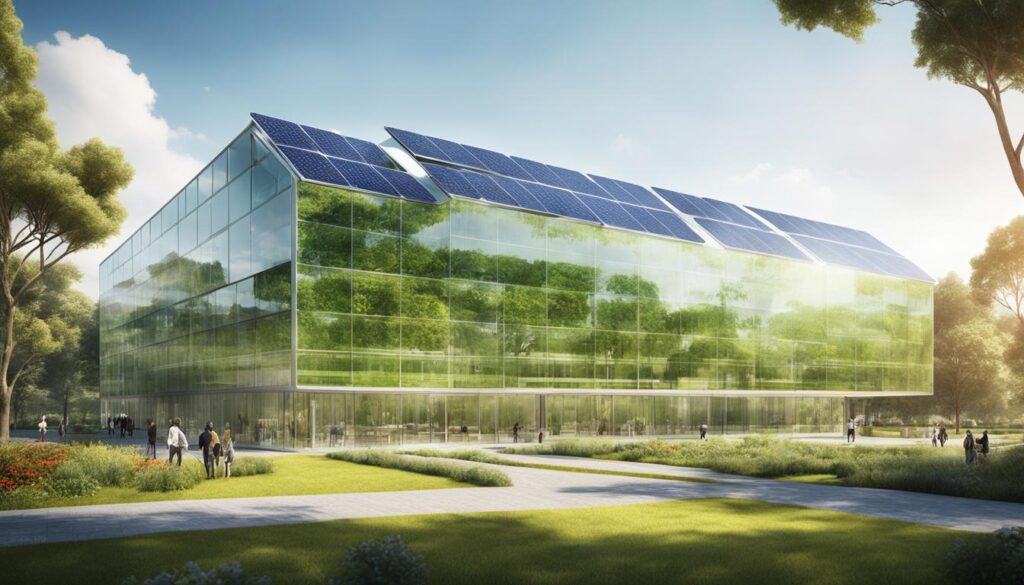Transparent solar panels, a ground-breaking technology in the field of solar energy solutions,have emerged as a promising avenue for a sustainable and renewable energy future. These innovative panels are designed to be transparent, allowing them to seamlessly integrate into buildings and other applications while harnessing the power of the sun to generate electricity.
With their ability to blend into various structures, transparent solar panels not only provide an aesthetically pleasing solution but also contribute to a cleaner and more energy-efficient world. By leveraging the abundant source of solar energy, these panels pave the way for a clear energy future that is both environmentally friendly and economically viable.
Key Takeaways:
- Transparent solar panels offer a transformative approach to sustainable energy solutions.
- These panels are designed to be transparent, allowing light to pass through while generating electricity.
- By seamlessly integrating into buildings and other applications, transparent solar panels contribute to a visually appealing and energy-efficient future.
- They harness the power of the sun, making renewable energy accessible and environmentally friendly.
- Transparent solar panels pave the way for a cleaner and more sustainable energy future.
Redefining Renewable Energy with Transparent Solar Technology
Transparent solar panels are redefining the landscape of renewable energy by combining functionality and aesthetics. These innovative panels allow for the seamless integration of solar power systems into various applications, transforming traditional building materials into sources of clean energy. With the advancement of photovoltaic technology, transparent solar panels pave the way for a sustainable future powered by green technology
How Transparent Solar Panels Work: A Technological Overview
Transparent solar panels harness the power of the sun by selectively capturing invisible wavelengths of light, such as ultraviolet (UV) and infrared (IR), while allowing visible light to pass through. This unique technology is made possible through the use of clear luminescent solar concentrators (TLSC). TLSCs contain organic salts that absorb the UV and IR light and convert it into another invisible wavelength.
The newly converted wavelength is then directed to the edge of the transparent solar panel, where thin photovoltaic strips convert it into electricity. This process enables transparent solar panels to generate electricity without compromising their visual transparency. By efficiently utilizing different wavelengths of light, transparent solar panels maximize energy production while maintaining their aesthetic appeal.
Understanding the Clear Luminescent Solar Concentrator (TLSC)
The clear luminescent solar concentrator (TLSC) is a key component of transparent solar panels. TLSCs contain a matrix of small organic salts that absorb UV and IR light, similar to traditional solar panels. However, instead of converting the light into electricity directly, TLSCs reroute the absorbed energy to the edge of the panel, where it is converted by thin photovoltaic strips.
This unique approach allows transparent solar panels to maintain their transparency while efficiently harnessing solar energy. TLSCs can be integrated into various materials, making them adaptable to different applications such as windows, screens, and surfaces. By incorporating TLSCs into everyday objects, transparent solar panels offer an unobtrusive and visually appealing solution for renewable energy generation.

| Advantages of Transparent Solar Panels: | Challenges and Considerations: |
|---|---|
|
|
Transparent Solar Panels: The Path to Sustainable Architecture
Transparent solar panels offer a promising path towards sustainable architecture. They can be seamlessly integrated into buildings, replacing traditional glass windows, and providing both aesthetic appeal and functional energy generation. By utilizing transparent solar panels, architects and designers can create energy-efficient buildings that reduce reliance on external energy sources and contribute to a greener future.
Industry Pioneers in Transparent Solar Cell Technology
Several companies and research institutions are at the forefront of developing transparent solar cell technology. These industry pioneers are pushing the boundaries of solar energy integration in architectural design. Let’s take a look at some key players in the field:
| Company/Institution | Key Contributions |
|---|---|
| SolarWindow Technologies, Inc. | Developing transparent solar coatings that can be applied to glass surfaces, generating electricity from both natural and artificial light sources. |
| Ubiquitous Energy | Creating transparent solar panels that can be seamlessly integrated into windows, allowing buildings to generate solar energy while maintaining high transparency. |
| Michigan State University | Researching and developing transparent luminescent solar concentrators (TLSCs) that selectively capture ultraviolet and infrared light to generate electricity, making them suitable for integration into various architectural elements. |
These industry pioneers are pushing the boundaries of solar cell technology, making sustainable architecture a reality. Their innovative solutions not only generate clean energy but also contribute to the aesthetic appeal of buildings and the overall well-being of their occupants.

Visually appealing and environmentally friendly, transparent solar panels are paving the way for a greener future in sustainable architecture. With ongoing advancements in solar cell technology, it’s clear that transparent solar panels are poised to revolutionize the way we design and construct buildings.
Conclusion
The integration of transparent solar panels in various applications offers both aesthetic and functional benefits. These panels seamlessly blend into buildings, vehicles, and electronic devices, providing a visually appealing and energy-efficient solution. By harnessing the power of the sun in a transparent and innovative way, transparent solar panels pave the way for a sustainable energy future.
Transparent solar panels not only generate clean and renewable energy but also contribute to the overall design and architecture of a space. With their ability to replace traditional glass windows, these panels enable buildings to become self-sufficient in terms of energy consumption. This not only reduces dependence on external energy sources but also minimizes the carbon footprint of the building.
Furthermore, the use of transparent solar panels in vehicles and electronic devices can significantly enhance their energy efficiency. By integrating these panels into the design, vehicles can generate electricity to power onboard systems, reducing the reliance on fossil fuels and decreasing emissions. Similarly, electronic devices, such as smartphones and tablets, can utilize transparent solar panels to extend their battery life and reduce the need for frequent charging.
In conclusion, transparent solar panels offer a promising solution to our energy needs while simultaneously blending with our surroundings. From buildings to vehicles and electronic devices, these panels showcase the potential for a more sustainable and energy-efficient future. By embracing transparent solar technology, we can create a world where renewable energy is seamlessly integrated into our everyday lives, ensuring a cleaner and brighter future for generations to come.
FAQ
What are transparent solar panels?
Transparent solar panels are innovative panels that allow light to pass through while generating electricity. They can seamlessly integrate into buildings and other applications, offering a promising pathway towards a clear energy future.
How do transparent solar panels work?
Transparent solar panels selectively harness invisible wavelengths of light, such as ultraviolet (UV) and infrared (IR), while allowing visible light to pass through. They utilize a clear luminescent solar concentrator (TLSC) that converts UV and IR light into another invisible wavelength and then into electricity.
What are the benefits of transparent solar panels in architecture?
Transparent solar panels can be seamlessly integrated into buildings, replacing traditional glass windows. This not only provides aesthetic appeal but also generates electricity, resulting in energy-efficient buildings that contribute to a greener future.
Can transparent solar panels be used in other applications?
Yes, transparent solar panels can be integrated into various applications, including vehicles and electronic devices. They offer both functional benefits and an aesthetically pleasing solution for harnessing the power of the sun.

